
who has always been a downright internationalist, they have all,
among other things, worked with full consciousness for the nationalising
of Norwegian art, have tried to free themselves from
foreign influences, whose transitory usefulness they acknowledged,
but in whose lasting dominion they saw the greatest danger for
artistic originality and depth. All the stranger is it that the most
strongly influenced by French art is the peasant-born C h r i s t i a n
S k r e d s v ig (born 1854). In his earlier productions, he actually
stands out from the Norwegian naturalistic artists as the least
Norwegian of them all. On returning home, however, after his
years of apprenticeship in France, it was not long before the
peasant, lyric instinct in him obtained the mastery over the artistic,
and in his later work, he has returned with full consciousness to
the country districts and the recollections of his childhood. But
all through there runs an undertone of/something foreign and
highly cultured in his manipulation and colouring. After 1874 he
studied in Pans, where his «Ferme a Vernoix» was purchased by the
French State, while his «Landskab fra Corsica» was purchased for
the Luxembourg Gallery. We will also mention his large picture
of the plains of Grez, his «Ballade», «Paa vildstraa» (On the Wrong
Scent), «St:-Hansfest» (Midsummer Eve), «Taldrisvisa»_ (a series of
water-colour drawings), «Menneskens son» (the Son of Man), which
recalls Uhde’s style, and especially «Vinje’s bamdomshjem»’(Home
of Vinje’s Childhood).
N i c o l a i U l f s t e n (1853—1885), the talented painter of
Lister’s stony shores, and the sea-washed sands of Jiederen, was a
discoverer in Norwegian landscape-painting. He was a clever
painter, a distinguished colourist, and a sure draughtsman. His
sketches and studies have an almost impressionistic freshness, and
pictures an altogether superior character.
J a c o b G l o e r s e n (born 1852) takes his subjects from the thick
forest and the snowclad ridges, as in «Paa rudgepost» (On the
Look-out for Woodcock), «Snefok» (Snow-storm). '
K i t t y K i e l l a n d ( b o r n 1844) a l s o t a k e s m o s t o f h e r s u b j e c t s
r o m J s e d e r e n , b u t i t i s t h e m a r s h e s a n d s a n d - h i l l s f a r t h e r i n l a n d
n o t t h e c o a s t .
The most able and talented Norwegian lady-artist is H a r r i e t
B a c k e r , (bom 1845). Interiors are her special province, and there
is no Norwegian artist who has seen indoor colours more delicately,
richly and characteristically harmonised than she, or who has